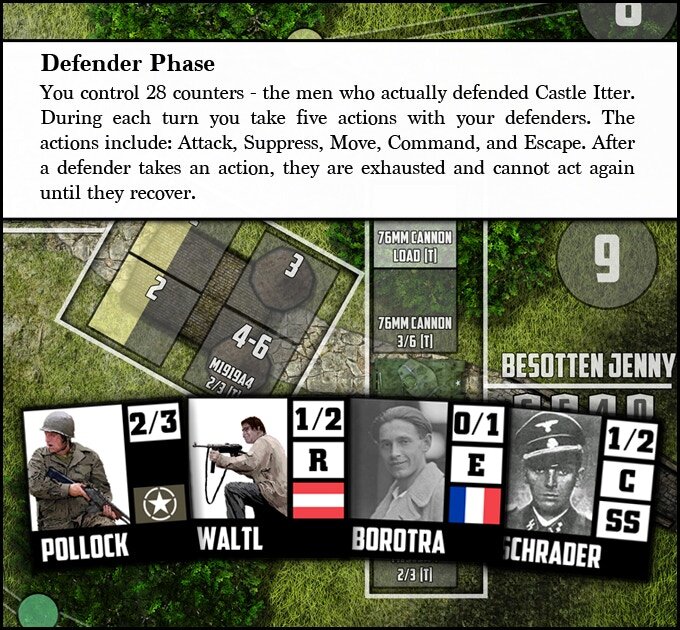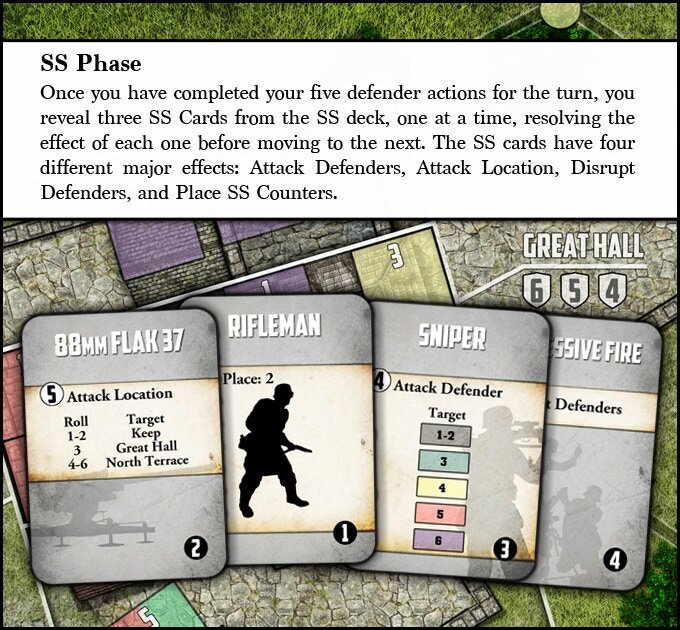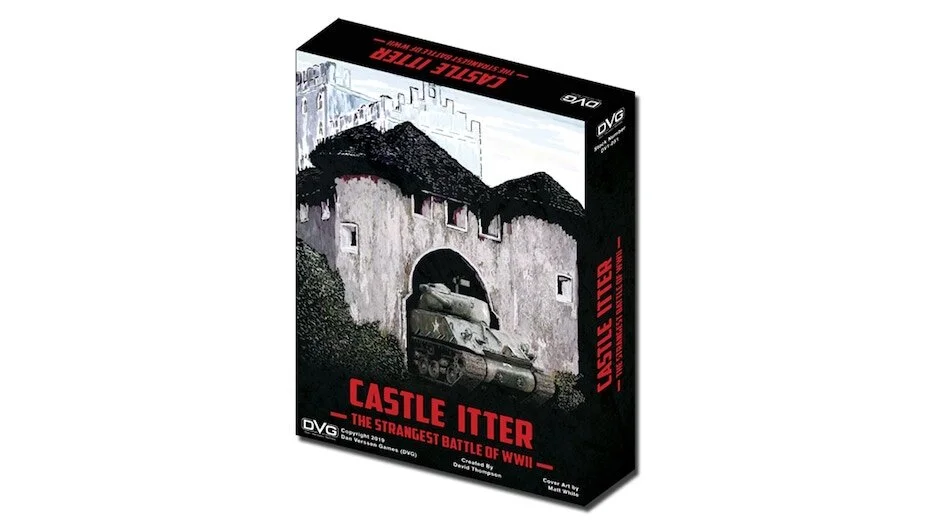Battle for Castle Itter by Simple History YouTube Channel
Review copy provided by Dan Verssen Games
Designer David Thompson has engineered Castle Itter, a solitaire board game experience, based on a fascinating story from World War II. The 19th-century castle stands in Tyrol, Austria near the small village of Itter. Used as a Nazi prison for French prisoners of war, it was defended by the U.S. Army, German Wehrmacht, Austrian Resistance, and the prisoners themselves against the Waffen-SS.
Castle Itter is the sequel to Pavlov’s House, another game in the Valiant Defense series created by David Thompson. The military board games are designed to elevate stories of courageous moments in history where small forces held back overwhelming attackers. Historical accuracy is foundational to the Valiant Defense series, and Castle Itter continues that legacy.
Lengthy historical research was undertaken to ensure accuracy and to elicit curiosity from the players. The rules are easy to learn, as the game alternates between Defender and SS phases, and a session will last between 45-60 minutes. Let’s examine what makes Castle Itter so unique.
STORY
The Battle of Castle Itter was fought near the Austrian village of Itter on 5 May 1945, in the last days of the war in Europe during World War II. US soldiers joined forces with Wehrmacht infantrymen, an SS officer, an Austrian resistance fighter, and recently freed French prisoners of war to defend the castle against an attacking force from the 17th SS Panzergrenadier Division.
A historical event, the Battle of Castle Itter might be the only time that Americans and Germans fought as allies during World War II. It’s one of the strangest battles in military history.
GAMEPLAY
The game board depicts Castle Itter and the separate buildings that comprise the structure. The main building is divided into the North and South Terraces, the Keep, the Great Hall, and the Cellar. The Gate House and the lone tank Besotten Jenny are further east. Surrounding the castle are the attack points at which the SS forces will assault the beleaguered defenders.
Setting up a game is relatively simple. The five French prisoners start in the cellar, but twenty other defenders and three reinforcements will start off the board, in the supply and to the side.
The difficulty will determine the strength of the starting SS forces, but the beginning game will spawn Riflemen across all of the surrounding locations from where the 17th SS Panzergrenadier Division advanced toward Castle Itter.
All of the castle’s six locations will start at full strength, and the first four rounds will require the player to place five defenders from the supply until all twenty of the initial defense force are on the board.
After setup, play is divided into two phases: the Defender phase and the SS phase. Players will perform five actions.
And then three SS cards will be drawn and resolved in order.
The game continues like this until either the player has lost, the SS deck has been depleted, or the 142nd Infantry Regiment card has been drawn from the SS deck.
Then players tally up the points to determine the margin of victory.
Castle Itter is a lot of fun. Managing the tank crew in the Besotten Jenny as the tank endures an onslaught from the SS forces is nerve-wracking. Relying upon more offensive defenders—or soldiers emboldened by French prisoners—to deal with Sturm infantry, machine gun positions, and mortar teams is always tense. Missing an attacking roll on a line of advancing SS soldiers is brutal, and it makes the SS phase an anxiety-inducing affair as you hope that your disrupted soldiers are not targeted nor your suppressing fire ineffective.
A deck of Tactics cards will influence the game when players try Castle Itter on higher difficulties. They enhance the strategical ploys of the SS and the danger of the assault. Players must be ready to adapt, and a more nuanced approach to the varied Defender actions is necessary. You can’t just attack with every defender. Suppression, movement, and the special actions specific to officers, French prisoners, and other personnel will be essential if you plan to survive the attack.
All of the mechanics create an atmosphere that reinforces the realism of the game. The Wehrmacht riflemen have low morale, which makes sense given their strange position in the fight. The released French prisoners are able to encourage and support the military efficiency of the personnel around them. Only the tank crew is able to operate Besotten Jenny and the heavy firepower on the front lines. Commanding officers are able to marshal the strength of the troops around them when they’ve been disrupted by enemy fire and artillery bombardment. Sniper fire and artillery strikes happen at random locations, which intensifies the player’s uncertainty.
Everything combines for an exciting defensive engagement. Castle Itter succeeds in establishing simplistic mechanics that get out of the way of the story and the experience.
VISUALS
The mounted 33” x 17” game board is a satellite image of the castle and its grounds that, while not topographic, lends another element of realism to the game. The SS counters are nondescript illustrations of riflemen, scouts, Sturm infantry, machine gunners, and mortar teams. The Defender counters, however, are the real soldiers and prisoners that took part in the Battle of Castle Itter. You can use simple colored tokens or wooden cubes to denote the status of the game, but all of the visual design enhancements the historical accuracy and the military realism of the game.
It’s an excellent portrayal that can function as a print-and-play solitaire experience, but the official board game version of Castle Itter is worth the investment.
REPLAYABILITY
In an hour or less, you can engage in a challenging solo campaign to fend off the SS assault on Castle Itter, and that gameplay is well worth the time. With different degrees of victory and higher tiers of difficulty, Castle Itter also guarantees that this will not be a one-and-done kind of game. Players can go back to test their strategic powers against the ever-determined 17th SS Panzergrenadier Division.
WHAT IT COULD HAVE DONE BETTER
The box design and the game components were some of the features that could be improved. Castle Itter has a lot of components, from the Defender and SS counters to the status tokens that mark the state of the battlefield. Yet the box includes a flimsy cardboard insert that funnels all of the game pieces into one trough. It’s a mess. A simple tray insert would have organized all of the components into easily discernible piles, but if you don’t separate the tokens and counters into baggies of your own accord, setting up the game every time will be laborious.
Premium tokens would have added a nice touch to the game as well. Players can choose between cardboard tokens and wooden cubes to keep track of the fight at Castle Itter, but some metal pieces or other design choices could have elevated the quality of the game.
Designing a box that’s appropriate for the content of the game is important to me as it streamlines the efficiency of play. Castle Itter succeeds in constructing a narrative experience and military encounter that emphasizes efficiency, but the physical pieces of the game do not all reflect that same mindset.
VERDICT
Castle Itter is a solid wargame and a wonderful solitaire tabletop experience. I thoroughly enjoyed the fight, and I look forward to many more battles against the SS in the future. If you’re interested in a nail-biting solo game or a realistic military operation, then Castle Itter will fit the bill.






















